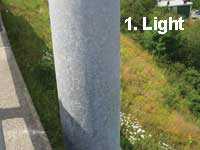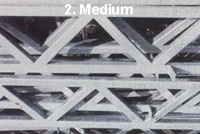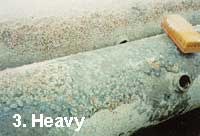Wet Storage Stain
Wet storage stain is the bulky white or gray deposit formed by accelerated corrosion of the zinc coating when closely packed, newly galvanized articles are stored or shipped under damp and poorly ventilated conditions. Weathered zinc surfaces which have already formed their normal protective layer of zinc corrosion products are seldom attacked. Wet storage stain is found most often on stacked and bundled items, such as galvanized sheets, plates, angles, bars, and pipe.
The extent of the damage caused by wet storage stain depends on the duration of exposure to retained moisture with little airflow over the galvanized coating. In the vast majority of cases, wet storage stain is light and does not necessarily imply any likely reduction in the expected life of the product. However, medium and heavy build-up can cause extreme damage to the coating when left untreated and may require stripping and regalvanizing. Examples can be seen below.



Prevention of wet storage stain includes not tightly stacking newly galvanized products on top of one another, removing standing water, and providing adequate air flow over the zinc surfaces.
Newly galvanized articles should be stored under cover in dry and well ventilated areas. If outdoor stacking is unavoidable, the articles should be raised from the ground and separated with strip spacers to provide free access of air to all parts of the surface. They also should be inclined in a manner which will give maximum drainage. Galvanized steel should not be stored on wet soil or decaying vegetation.
The use of spacers is recommended during any shipping if there is a likelihood of condensation. It is important that resinous wood not be used for spacers or packing, since the resin itself can start corrosion. Woods used in transporting should be dry and untreated with preservatives or fire retardant chemicals. Poplar and spruce have been used with good results. Untreated wood cannot be transported across the United States/Canada border.
Passivation agents, such as chromates, are sometimes applied to galvanized articles immediately after galvanizing to prevent wet storage stain. Other passivation agents such as clear coats and oils have also been used to prevent wet storage stain. Proper storage of galvanized steel is necessary even when passivation agents are used.
White rust can occur on unpassivated cooling towers in service in water with a pH level above 8.2 or 8.3. If the cooling towers cannot be chromate quenched, the solution is to use a phosphate treatment and operate the tower at a pH no higher than 7.8 for a few months, then return to normal operating levels.
© 2025 American Galvanizers Association. The material provided herein has been developed to provide accurate and authoritative information about after-fabrication hot-dip galvanized steel. This material provides general information only and is not intended as a substitute for competent professional examination and verification as to suitability and applicability. The information provided herein is not intended as a representation or warranty on the part of the AGA. Anyone making use of this information assumes all liability arising from such use.

